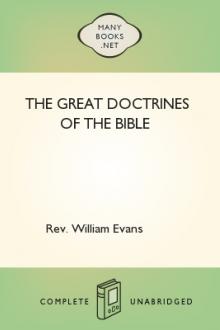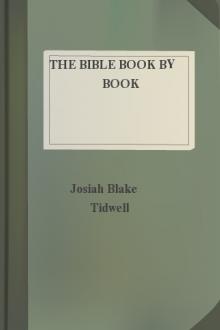The Great Doctrines of the Bible by Rev. William Evans (best books to read for self improvement TXT) 📖

- Author: Rev. William Evans
- Performer: -
Book online «The Great Doctrines of the Bible by Rev. William Evans (best books to read for self improvement TXT) 📖». Author Rev. William Evans
THE RESURRECTION OF JESUS CHRIST.
I. ITS IMPORTANT PLACE IN THE CHRISTIAN RELIGION.
1. IT HOLDS A UNIQUE PLACE IN CHRISTIANITY.
Christianity is the only religion that bases its claim to acceptance upon the resurrection of its founder. For any other religion to base its claim on such a doctrine would be to court failure. Test all other religions by this claim and see.
2. IT IS FUNDAMENTAL TO CHRISTIANITY.
In that wonderful chapter on the resurrection (1 Cor. 15) Paul makes Christianity answer with its life for the literal truth of the resurrection of Jesus Christ. That the body of the founder of the Christian religion did not lie in the grave after the third day is fundamental to the existence of the religion of Christ: “And if Christ be not risen, then is our preaching vain, and your faith is also vain” (v. 14). “If Christ be not raised … ye are yet in your sins” (v. 17). “Then they also which are fallen asleep in Christ are perished” (v.18). Remove the resurrection from Paul’s Gospel, and his message is gone. The resurrection of Jesus Christ is not an appendage to Paul’s Gospel; it is a constitutive part of it.
The importance of this doctrine is very evident from the prominent part it played in the preaching of the Apostles: Peter—Acts 2:24, 32; 3:15; 4:10; 5:30; 10:40; 1 Peter 1:21, 23. Paul—Acts 13:30, 34; 17:31; 1 Cor. 15; Phil. 3:21. It was belief in such preaching that led to the establishment of the Christian church. Belief in the resurrection of Christ was the faith of the early church (Acts 4:33). The testimony to this great fact of Christian faith was borne in the midst of the fiercest opposition. Nor was it controverted, although the grave was well known and could have been pointed out. It was in this fact that Christianity acquired a firm basis for its historical development. There was not only an “Easter Message,” there was also an “Easter Faith.”
Our Lord’s honor was, in a sense, staked upon the fact of His resurrection. So important did He regard it that He remained forty days upon the earth after His resurrection, giving many infallible proofs of the great fact. He appealed to it again and again as evidence of the truth of His claims: Matt. 12:39, 40; John 2:20-22.
Both the friends and the enemies of Christianity admit that the resurrection of Jesus Christ is vital to the religion that bears His name. The Christian confidently appeals to it as an incontrovertible fact; the sceptic denies it altogether as a historical reality. “If the resurrection really took place,” says an assailant of it, “then Christianity must be admitted to be what it claims to be—a direct revelation from God.” “If Christ be not risen,” says the Apostle Paul, “then is our preaching vain, and your faith is also vain.” The one tries all he can to do away with the proofs submitted for the accepted fact; the other plainly says that if the resurrection cannot be believed, then Christianity is nothing but a sham. If the resurrection of Christ can be successfully denied, if it can be proven to be absolutely untrue, then the whole fabric of the Gospel falls to pieces, the whole structure of the Christian religion is shaken at its foundation, and the very arch of Christianity crumbles into dust. Then it has wrought only imaginary changes, deluded its most faithful adherents, deceived and disappointed the hopes of its most devoted disciples, and the finest moral achievements that adorn the pages of the history of the Christian church have been based upon a falsehood.
Nor must we ignore the prominent place the resurrection of Jesus Christ occupies in the Scriptures. More than one hundred times is it spoken of in the New Testament alone.
II. THE NATURE OF THE RESURRECTION OF JESUS CHRIST.
1. JESUS CHRIST ACTUALLY DIED.
Some who disbelieve in the resurrection of Christ assert that Jesus merely swooned, and that pitying hands took Him down from the cross, thinking that He had died. The cool air of the tomb in which He was placed revived Him, so that He came forth from the tomb as though He had really risen from the dead. The disciples believed that He had really died and risen again.
This theory is false for the following reasons:
Jesus Christ appeared to the disciples after the third day, not as a weak, suffering, half-dead man, but as a conquering, triumphant victor over death and the grave. He never could have made the impression upon the disciples that He did, if He had presented the picture of a sick, half-dead man.
From John 19:33-37 we learn that when the soldiers pierced the side of Christ, there came forth blood and water. Physiologists and physicists agree that such a condition of the vital organs, including the heart itself, precludes the idea of a mere swoon, and proves conclusively that death had taken place.
Joseph of Arimathaea asked permission to bury the body of Jesus because he knew that Jesus had been pronounced dead (Matt. 27:57,
58).
When the news was brought to Pilate that Christ had died, it is said that “Pilate marvelled if he were already dead: and calling unto him the centurion, he asked him whether he had been any while dead. And when he knew it of the centurion, he gave the body to Joseph” (Mark 15:44, 45).
The women brought spices to anoint a dead body, not a half-dead Christ (Mark 16:1).
The soldiers pronounced Him dead: “But when they came to Jesus, and saw that he was dead already, they brake not his legs” (John 19:33).
Jesus Christ Himself, He who is the Truth, testifies to the fact that He had really died: Rev. 1:18—“I am he that liveth, and was dead.”
2. THE FACT THAT CHRIST’S BODY WAS ACTUALLY RAISED FROM THE DEAD.
The resurrection of Christ is not a spiritual resurrection, nor were his appearances to the disciples spiritual manifestations. He appeared to His disciples in a bodily form. The body that was laid in Joseph’s tomb came forth on that first Easter morn twenty centuries ago.
Some maintain that it is not vital to belief in the resurrection of Christ that we insist on a literal resurrection of the body of Jesus; all that we need to insist on is that Christ was ever afterwards known to be the victor over death, and that He had the power of an endless life. So it comes to pass that we have what is called an “Easter Message,” as contrasted with an “Easter Faith” which believes in the literal resurrection of Jesus Christ from the dead. “Faith has by no means to do with the knowledge of the form in which Jesus lives, but only with the conviction that He is the living Lord.”—_Harnack_ in What is Christianity? According to this theory, belief in Christ’s resurrection means nothing more than belief in the survival of the soul of Jesus—that somehow or other Jesus was alive, and lived with God, while His body yet saw corruption in the grave.
We reply: This cannot be, for all the facts in the Gospel narratives contradict such a theory. Let us examine these narratives.
a) We are Confronted by the Fact of an Empty Tomb.
Matt. 28:6; Mark 16:6; Luke 24:3, 12; John 20:1, 2. The fact that the tomb was empty is testified to by competent witnesses —both friends and enemies: by the women, the disciples, the angels, and the Roman guards. How shall we account for the absence of the body of Jesus from the tomb? That it had not been stolen by outside parties is evident from the testimony of the soldiers who were bribed to tell that story (Matt. 28:11-15). Such a guard never would have allowed such a thing to take place. Their lives would have been thereby jeopardized. And if they were asleep (v. 13), how could they know what took place? Their testimony under such circumstances would be useless.
The condition in which the linen cloths were found lying by those who entered the tomb precludes the possibility of the body being stolen. Had such been the case the cloths would have been taken with the body, and not left in perfect order, thereby showing that the body had gone out of them. Burglars do not leave things in such perfect order. There is no order in haste.
Then again, we have the testimony of angels to the fact that Jesus had really risen as foretold (Matt. 28:6; Mark 16:6). The testimony of angels is surely trustworthy (Heb. 2:2).
b) There are Other Resurrections Mentioned in the Gospel Records which were Undoubtedly Bodily Resurrections.
Matt. 9:18-26; Luke 7:11-18; John 11:1-44. These incidents throw light upon the resurrection of Jesus. Why did the officers say that they were afraid “that his disciples should come by night and steal him away” if they did not refer to the body of Jesus? They surely could not steal His soul.
c) Those Who Saw Him After the Resurrection Recognized Him as Having the Same Body as He Had Before, Even to the Wound Prints.
John 20:27; Luke 24:37-39. It is true that there were occasions on which He was not recognizable by the disciples, but such occasions were the result of the eyes of the disciples being holden in order that they might not know him. There was divine intervention on these occasions. Does Christ still retain the prints of the nails? Is He still the Lamb as though it had been slain? (Rev. 5 and 6).
d) There Can Be No Doubt of the Fact that the Apostle Paul Believed in the Bodily Resurrection of Christ.
The Corinthians, to whom the apostle wrote that wonderful treatise on the resurrection (1 Cor. 15), were not spending their time denying a spiritual resurrection; nor was the apostle spending his time trying to produce convincing arguments for a spiritual resurrection. (See also Rom. 8:11.)
e) It is Clear also from Christ’s Own Testimony Before and After the Resurrection.
Matt. 17:23; Luke 24:39; Rev. 1:18. No other construction can legitimately be put upon these words than that Christ here refers to the resurrection of His body.
f) The Apostolic Testimony Corroborates this Fact.
Acts 2:24-32; 1 Pet. 1:3, 21; 3:21. Peter was at the tomb; he it was who stepped inside and saw the linen cloths lying. His testimony ought to be beyond question as to the fact at issue.
g) The Record of the Appearances of Christ Prove a Literal, Physical Resurrection.
Matt. 28:9, 10; John 20:14-18, cf. Mark 16:9; Luke 24:13-32; John 21, etc. All these appearances bear witness to the fact that it was not an incorporeal spirit or phantom, but a real, bodily Christ that they saw. He could be seen, touched, handled; He was recognizable; He ate and drank in their presence.
h) Lastly, Many Passages in the Scriptures Would Be Unintelligible Except on the Ground of a Bodily Resurrection of Jesus Christ from the Grave.
Rom. 8:11, 23; Eph. 1:19, 20; Phil. 3:20, 21; 1 Thess. 4:13-17.
3. THE NATURE OF THE RESURRECTION BODY OF CHRIST.
a) It was a Real Body; not a Ghost, nor a Phantom.
That the resurrection body of Jesus was not a phantom, but a body composed of “flesh and bones” is evident from Luke 24:36-43. It could be “touched”





Comments (0)